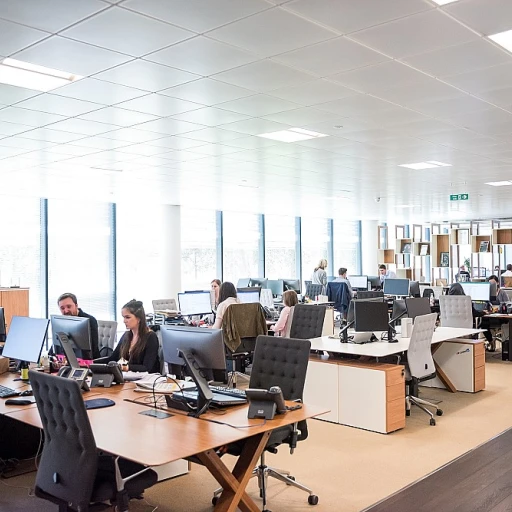Understanding the Role of Office Cubicle Doors
The Importance of Office Cubicle Doors
Office cubicle doors play a significant role in enhancing both privacy and productivity within a workplace environment. These structures are more than just physical barriers; they are designed to streamline workflow while maintaining an atmosphere conducive to effective communication.
In India, where office spaces often accommodate a large number of employees, the cubicle concept provides an efficient solution. Installing cubicle door systems like sliding doors or privacy screens can drastically enhance work focus by reducing distractions.
Furthermore, the inclusion of office cubicle doors allows for a tailored work environment, with options ranging from sliding doors to curtains that fit seamlessly within the existing office furniture setup. Enhanced privacy through cubicle doors leads to fewer disruptions, allowing employees to complete tasks more efficiently.
For those interested in creating an optimal work environment, exploring techniques like enhancing workplace efficiency with visual management techniques can further complement the improved privacy and personal space provided by these doors. When considering design and functionality, office cubicle doors offer a flexible solution that adapts to diverse office demands, thus highlighting their crucial role in the modern office landscape.
Challenges in Implementing Office Cubicle Doors in India
Overcoming Barriers to Implementation
India's bustling office environments often pose unique challenges when it comes to implementing office cubicle doors. Here, we explore some common barriers and consider strategies to address them effectively.
One significant challenge lies in the cultural context of Indian workplaces, where open and collaborative environments are highly valued. The introduction of cubicle doors might be perceived as counterproductive to team cohesion and collaboration. Therefore, it’s crucial to communicate the functional benefits of cubicle privacy and demonstrate how it aligns with workplace culture.
Space constraints are another factor to consider. With many companies opting for compact office designs, the integration of sliding doors or screen panels can be challenging. It's essential to explore space-saving options such as sliding cubicle and sliding door solutions that offer privacy without compromising on room accessibility.
The price of cubicle doors can also serve as a hindrance, especially for smaller companies operating under financial limitations. Budget-friendly solutions, like curtain partitions or privacy screens, can be leveraged to balance cost and functionality.
Industrial logistics, including delivery ships constraints and timely implementation, can impact the adoption of cubicle office furniture. Sourcing local suppliers to mitigate delays and reduce costs associated with distant delivery locations can enhance project efficiency.
Moreover, the alignment of door cubicle designs with existing office furniture and decor is vital. Companies need to consider the visual appeal and functionality of their office environment, ensuring a seamless integration that doesn't disrupt the aesthetics or workflow.
By addressing these challenges, office managers can successfully implement office cubicle doors, enhancing both privacy and productivity within their teams. Further insights into workplace dynamics can be explored in our detailed guide on
navigating the dynamics of office life in Indian companies.
Benefits of Office Cubicle Doors for Office Managers
Empowering Office Managers with Privacy and Productivity
Implementing cubicle doors in your office can have significant advantages, particularly for office managers striving to maintain an optimal work environment. The integration of cubicles with sliding doors or privacy panels can lead to enhanced privacy, crucial for sensitive conversations and tasks requiring focus. Notably, they serve as both a physical and a psychological barrier, reducing unnecessary noise and distractions, allowing employees to concentrate more effectively.
Office managers constantly balance between creating a collaborative atmosphere and maintaining individual productivity. Installing features like cubicle doors and sliding screens offers a solution, providing a space that feels personal yet connected. Whether the choice is a stylish privacy curtain or a more substantial door office setup, these additions can dramatically influence the workflow.
Furthermore, the strategic use of cubicle privacy solutions aids in managing work-related stress, contributing to a healthier work environment. When employees have control over their space, it not only boosts their productivity but also their satisfaction with their work environment.
Adopting a thoughtful design approach to office cubicle furniture, such as choosing versatile sliding doors or cubicle sliding panels, offers flexibility and can enhance office efficiency significantly. A well-planned office design that includes cubicle doors can finesse facilities management, ultimately promoting a more organized and productive space. Visit this
comprehensive maintenance log template for further insight into maintaining and enhancing workspace environments.
Design Considerations for Office Cubicle Doors
Factors to Consider When Choosing Office Cubicle Door Design
When selecting the design for office cubicle doors, there are several critical factors to consider that can greatly enhance both privacy and productivity.
- Space Optimization: In smaller office environments, it is essential to choose doors that maximize ease of movement and efficiency. Sliding doors are often preferred as they require less space compared to traditional swing doors.
- Privacy Needs: Depending on the level of privacy required, office managers might opt for solutions like privacy screens or curtains. Choosing the right cubicle panel that offers adequate soundproofing is also crucial, especially when sensitive work is involved.
- Aesthetic Appeal: The design of the cubicle doors should complement the existing office furniture and overall ambiance. Herman Miller and similar manufacturers offer diverse options that blend functionality with style.
- Materials and Durability: It's important to choose materials that are not only aesthetically pleasing but also durable and easy to maintain. Steel and laminated wood panels are popular for their long-lasting performance.
- Budgetary Constraints: Finding a balance between quality and price is vital. While some businesses might prioritize cost-effective options, others may invest more for high-end, durable products.
- Functional Versatility: In some cases, convertible cubicles that adapt to different tasks can be invaluable. Consider versatility, such as panels that can be easily rearranged or sliding cubicle doors that can transform spaces as needed.
While contemplating these aspects, one should ensure to weigh long-term benefits against immediate cost implications when selecting cubicles doors. Properly designed cubicle offices not only lead to enhanced employee satisfaction but also foster a productive and efficient work environment.
Cost Implications and Budgeting for Office Cubicle Doors
Budgeting for Office Cubicle Systems
When considering installing office cubicle doors, understanding the cost implications is crucial. The financial investment in cubicle systems can vary significantly based on factors like materials, design complexity, and additional elements such as sliding doors or privacy screens. Let's delve into the various aspects that affect the pricing and financial planning for office cubicles.
- Material and Design Selection: The choice of materials, such as wood, metal, or premium composites, and design intricacies, including sliding doors or acoustic panels, play a pivotal role in determining the overall cost. For instance, a basic panel might be more affordable compared to a customized door with a privacy coating.
- Customization Needs: Tailoring cubicles to fit specific office needs can add to the design cost. Whether opting for privacy screens or integrating high-tech features, consider these elements carefully when budgeting.
- Installation and Delivery: The cost of labor for installation and delivery charges can also influence the budget. Factors such as office location, the complexity of set-up, and additional features like cubicle doors or sliding partitions should be accounted for.
- Supplier Choice and Product Type: Choosing reputable suppliers who specialize in office furniture or products like Herman Miller can impact pricing. It's essential to compare prices and assess different product types to ensure cost-effectiveness without compromising quality.
- Long-Term Financial Benefits: While initial investments can seem high, the long-term productivity gains and enhanced privacy office cubicles bring can lead to substantial returns. Weighing immediate costs against potential future benefits is crucial for sound financial planning.
Effective budgeting involves a strategic approach that combines an understanding of design considerations with the ability to predict future trends. By doing so, companies can not only improve work environments but also achieve financial efficiency.
Future Trends in Office Cubicle Design
Emerging Trends in Cubicle Designs
As office environments continue evolving, cubicle design trends are also undergoing noteworthy transitions. The contemporary office space is characterized by flexibility, functionality, and an emphasis on employee wellbeing, aiming to harmonize privacy and collaboration.
One significant trend is the use of sliding doors in cubicles, which offer enhanced convenience and privacy. Sliding doors not only conserve space but also enhance the aesthetic appeal of an office. These doors are becoming increasingly popular as businesses strive to create sleek, modern work spaces. Additionally, innovations in materials for cubicle panels, such as sound-absorbing fabrics and privacy screens, are gaining traction, offering improved acoustics and visual privacy without sacrificing style.
Another notable development is the integration of technology into cubicle office designs. Smart desks and office furniture that adjust to individual needs are being paired with ergonomic seating solutions, facilitating a more productive environment. Incorporating digital screens for video conferences within cubicles allows for isolation when needed, also promoting an efficient means of communication.
Sustainability is playing an ever-expanding role in office design. Many companies are now opting for eco-friendly materials for cubicle curtains, panels, and furniture, reducing environmental impact while meeting modern design demands. As businesses are becoming more conscious of their carbon footprint, products designed from recycled materials are in higher demand.
Interest in remodelling office spaces to have more collaborative open layouts is on the rise, although the need for designated quiet zones remains critical. Privacy curtains in shared work environments offer adaptable solutions for creating instant cubicle privacy when necessary. The balance between collaborative zones and private cubicles is a key factor in modern office planning.
Finally, the fluctuating economic landscape is influencing office cubicle prices. As businesses seek cost-effective renovations, office managers are prioritizing budget-friendly options without compromising quality. Adapting to such trends can prove beneficial to business recovery and sustainability in the long term.
While the functionality of office cubicle doors is undeniable, staying up-to-date on these transformative design trends will empower office managers to enhance operational efficiencies and employee satisfaction within their workspaces.

